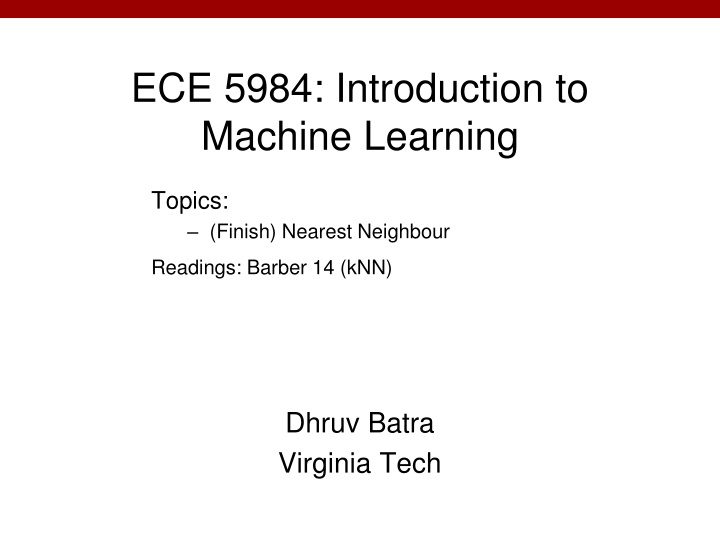
Memory-based Learning for Machine Learning Enthusiasts
Explore the concepts of memory-based learning in machine learning with a focus on nearest neighbors, distance metrics, and regression. Dive into the fundamentals of instance-based learning and understand the key components that make up a memory-based learner. Join the Kaggle competition for a hands-on implementation of K-NN and earn bonus points for exceptional performance.
Download Presentation

Please find below an Image/Link to download the presentation.
The content on the website is provided AS IS for your information and personal use only. It may not be sold, licensed, or shared on other websites without obtaining consent from the author. If you encounter any issues during the download, it is possible that the publisher has removed the file from their server.
You are allowed to download the files provided on this website for personal or commercial use, subject to the condition that they are used lawfully. All files are the property of their respective owners.
The content on the website is provided AS IS for your information and personal use only. It may not be sold, licensed, or shared on other websites without obtaining consent from the author.
E N D
Presentation Transcript
ECE 5984: Introduction to Machine Learning Topics: (Finish) Nearest Neighbour Readings: Barber 14 (kNN) Dhruv Batra Virginia Tech
Administrativia HW0 Graded. Grades available on Scholar. Everyone passed. Some are on the border. Please come see me. Solutions available Wed. HW1 Out today Due on Sunday 02/15, 11:55pm Please please please please please start early Implement K-NN Kaggle Competition Bonus points for best performing entries. Bonus points for beating the instructor/TA. http://inclass.kaggle.com/c/VT-ECE-Machine-Learning-HW1 (C) Dhruv Batra 2
Recap from last time (C) Dhruv Batra 3
Nearest Neighbours (C) Dhruv Batra Image Credit: Wikipedia 4
Instance/Memory-based Learning Four things make a memory based learner: A distance metric How many nearby neighbors to look at? A weighting function (optional) How to fit with the local points? (C) Dhruv Batra Slide Credit: Carlos Guestrin 5
1-Nearest Neighbour Four things make a memory based learner: A distance metric Euclidean (and others) How many nearby neighbors to look at? 1 A weighting function (optional) unused How to fit with the local points? Just predict the same output as the nearest neighbour. (C) Dhruv Batra Slide Credit: Carlos Guestrin 6
1-NN for Regression Here, this is the closest datapoint y x (C) Dhruv Batra Figure Credit: Carlos Guestrin 7
Multivariate distance metrics Suppose the input vectors x1, x2, xN are two dimensional: x1 = ( x11 , x12 ) , x2 = ( x21 , x22) , xN = ( xN1 , xN2 ). One can draw the nearest-neighbor regions in input space. Dist(xi,xj) = (xi1 xj1)2 + (xi2 xj2)2 Dist(xi,xj) =(xi1 xj1)2+(3xi2 3xj2)2 The relative scalings in the distance metric affect region shapes Slide Credit: Carlos Guestrin
Euclidean distance metric Or equivalently, A where Slide Credit: Carlos Guestrin
Notable distance metrics (and their level sets) Mahalanobis (non-diagonal A) Scaled Euclidian (L2) Slide Credit: Carlos Guestrin
Minkowski distance Image Credit: By Waldir (Based on File:MinkowskiCircles.svg) [CC BY-SA 3.0 (http://creativecommons.org/licenses/by-sa/3.0)], via Wikimedia Commons (C) Dhruv Batra 11
Notable distance metrics (and their level sets) Scaled Euclidian (L2) L1 norm (absolute) Mahalanobis (non-diagonal A) Linf (max) norm Slide Credit: Carlos Guestrin
Plan for today (Finish) Nearest Neighbour Kernel Classification/Regression Curse of Dimensionality (C) Dhruv Batra 13
Weighted k-NNs Neighbors are not all the same
1-NN for Regression Often bumpy (overfits) (C) Dhruv Batra Figure Credit: Andrew Moore 15
9-NN for Regression Often bumpy (overfits) (C) Dhruv Batra Figure Credit: Andrew Moore 16
Kernel Regression/Classification Four things make a memory based learner: A distance metric Euclidean (and others) How many nearby neighbors to look at? All of them A weighting function (optional) wi = exp(-d(xi, query)2 / 2) Nearby points to the query are weighted strongly, far points weakly. The parameter is the Kernel Width. Very important. How to fit with the local points? Predict the weighted average of the outputs predict = wiyi / wi (C) Dhruv Batra Slide Credit: Carlos Guestrin 17
Weighting/Kernel functions wi = exp(-d(xi, query)2/ 2) (Our examples use Gaussian) (C) Dhruv Batra Slide Credit: Carlos Guestrin 18
Effect of Kernel Width What happens as inf? What happens as 0? (C) Dhruv Batra Image Credit: Ben Taskar 19
Problems with Instance-Based Learning Expensive No Learning: most real work done during testing For every test sample, must search through all dataset very slow! Must use tricks like approximate nearest neighbour search Doesn t work well when large number of irrelevant features Distances overwhelmed by noisy features Curse of Dimensionality Distances become meaningless in high dimensions (See proof in next lecture) (C) Dhruv Batra 20
Curse of Dimensionality Consider: Sphere of radius 1 in d-dims Consider: an outer -shell in this sphere shell volume What is ? sphere volume (C) Dhruv Batra 21
Curse of Dimensionality (C) Dhruv Batra 22
What you need to know k-NN Simplest learning algorithm With sufficient data, very hard to beat strawman approach Picking k? Kernel regression/classification Set k to n (number of data points) and chose kernel width Smoother than k-NN Problems with k-NN Curse of dimensionality Irrelevant features often killers for instance-based approaches Slow NN search: Must remember (very large) dataset for prediction (C) Dhruv Batra 23
What you need to know Key Concepts (which we will meet again) Supervised Learning Classification/Regression Loss Functions Statistical Estimation Training vs Testing Data Hypothesis Class Overfitting, Generalization (C) Dhruv Batra 24
